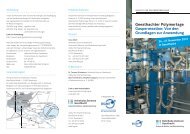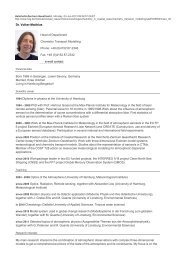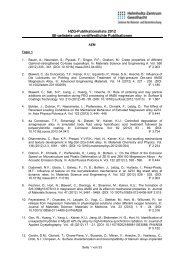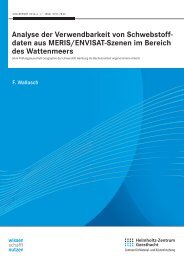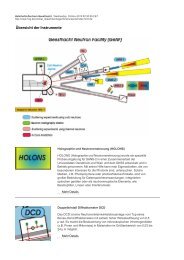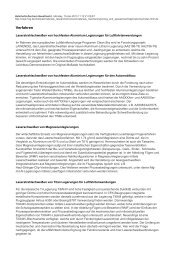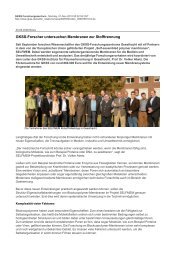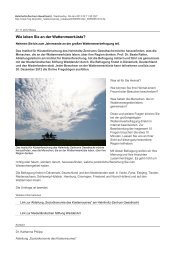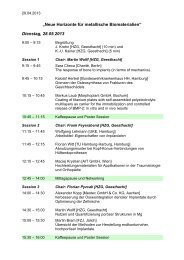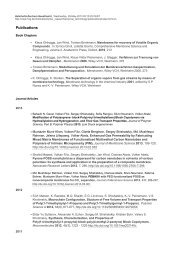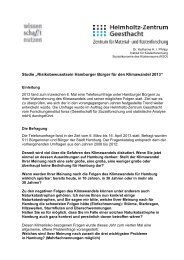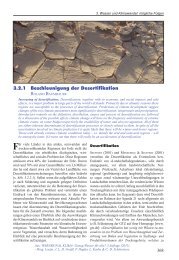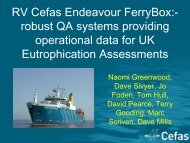High-resolution wave climate analysis in the Helgoland area - GKSS
High-resolution wave climate analysis in the Helgoland area - GKSS
High-resolution wave climate analysis in the Helgoland area - GKSS
You also want an ePaper? Increase the reach of your titles
YUMPU automatically turns print PDFs into web optimized ePapers that Google loves.
3.2 Wave model<strong>in</strong>g with empirical downscal<strong>in</strong>g techniques 33<br />
a) b) c)<br />
1<br />
LR/KMH CCA/KMH<br />
Analog/KMH<br />
1<br />
0.95<br />
0.95<br />
1<br />
Figure 3.4: Expla<strong>in</strong>ed variance of a) LR, b) CCA, c) Analog with respect to KMH.<br />
pattern is very similar to <strong>the</strong> first CCA pattern (Fig. 3.2) and expla<strong>in</strong>s 97% of total KMH<br />
<strong>wave</strong> height variance. This EOF pattern can be associated with <strong>the</strong> most frequent for <strong>the</strong><br />
<strong>area</strong> westerly w<strong>in</strong>d conditions, <strong>the</strong> same concerns <strong>the</strong> first EOF of <strong>the</strong> HF SWH dataset.<br />
The first EOF pattern has a major impact on subsequent CCA model construction and <strong>the</strong><br />
SWH fields reconstruction. This is followed by <strong>the</strong> limited ability of <strong>the</strong> CCA to downscale<br />
adequately <strong>the</strong> <strong>wave</strong> heights for o<strong>the</strong>r than westerly w<strong>in</strong>d situations.<br />
Similar behaviour of <strong>the</strong> SWH from <strong>the</strong> analog method is accompanied by <strong>the</strong> additional<br />
variability as illustrated by Figure 3.5. This is consistent with <strong>the</strong> overestimated variability<br />
for <strong>the</strong> western part of <strong>the</strong> model doma<strong>in</strong> (Fig. 3.4c). As it can be seen from Table 3.1<br />
and Figure 3.3, <strong>the</strong> analog method shows <strong>the</strong> worst performance among <strong>the</strong> tested methods<br />
not only for variability but also <strong>in</strong> terms of errors (bias or rms). Besides <strong>the</strong> use of EOF<br />
patterns which do not expla<strong>in</strong> all <strong>wave</strong> situations adequately (similar to CCA), <strong>the</strong> uncerta<strong>in</strong>ty<br />
and especially overestimated variability of <strong>the</strong> analog results can be attributed to<br />
<strong>the</strong> <strong>in</strong>completeness of <strong>the</strong> analog pool. For this method that means a fitt<strong>in</strong>g period longer<br />
than 5 years is required to accumulate <strong>the</strong> sufficient set of significant <strong>wave</strong> height patterns.<br />
This problem could be a strong limitation <strong>in</strong> <strong>the</strong> case of applications to scenario studies, as<br />
<strong>wave</strong> situations which did not occur dur<strong>in</strong>g <strong>the</strong> fitt<strong>in</strong>g period or which were not <strong>in</strong>cluded<br />
<strong>in</strong> <strong>the</strong> analog pool can not be detected and reproduced by this method.<br />
The l<strong>in</strong>ear regression shows stable performance <strong>in</strong>dependently on <strong>the</strong> external forces<br />
and w<strong>in</strong>d directions. The dom<strong>in</strong>ant westerly <strong>wave</strong> pattern and less frequent easterly <strong>wave</strong><br />
situations are represented adequately because <strong>the</strong>y were <strong>in</strong>itially separated and equally<br />
treated dur<strong>in</strong>g <strong>the</strong> model tra<strong>in</strong><strong>in</strong>g procedure. This gives <strong>the</strong> LR a superior quality relative<br />
to CCA and analog. The uncerta<strong>in</strong>ties observed <strong>in</strong> LR SWH representation are related to<br />
<strong>the</strong> <strong>in</strong>capability of <strong>the</strong> model to capture <strong>the</strong> small-scale time-variable fields like water depth<br />
variations, currents and correspondent shallow water processes <strong>in</strong> full. In general, <strong>the</strong> SWH<br />
1<br />
0.95<br />
0.9<br />
0.85<br />
0.8<br />
0.95<br />
1<br />
1.05<br />
0.95<br />
0.95<br />
1



